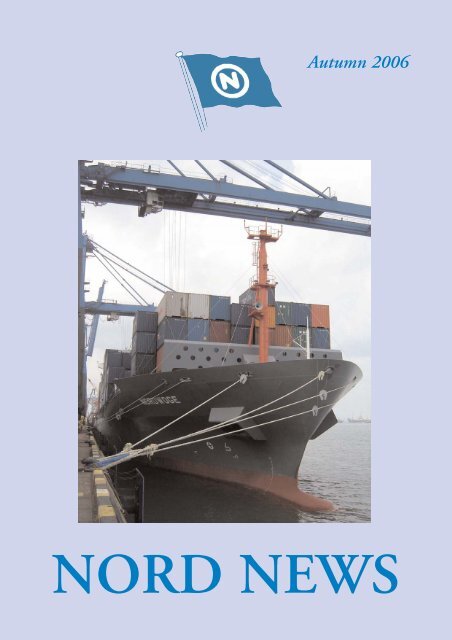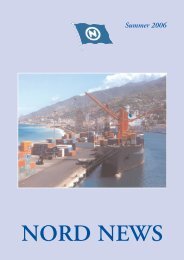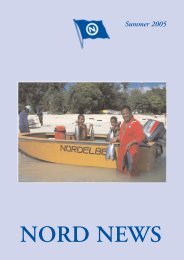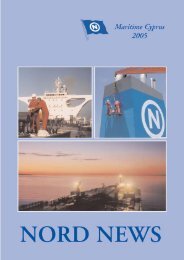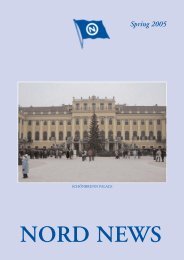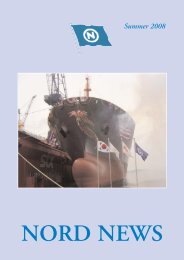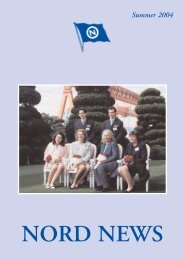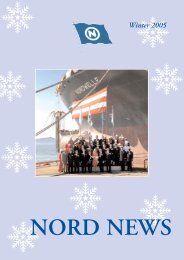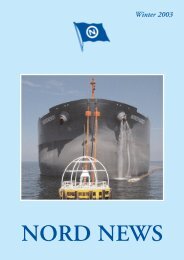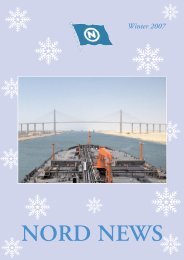Nord news
Nord news
Nord news
You also want an ePaper? Increase the reach of your titles
YUMPU automatically turns print PDFs into web optimized ePapers that Google loves.
Autumn 2006<br />
NORD NEWS
2<br />
G O O D B Y E “ N O R D S U N ”<br />
Insert: The last crew of MV “NORDSUN” the<br />
photo was sent in by Capt. Samaranayake<br />
Front Cover: MV “NORDWOGE” the photo<br />
was sent in by Capt. Galhena<br />
NORD NEWS Autumn 2006
Dear Seafarers and Readers!<br />
Looking back to this Summer, the main event for many of this world was the World<br />
Championship in Soccer 2006 that took place in Germany.<br />
Before the opening on June 9 th , we really did not have good weather in this country.<br />
However, it was remarkable, all of a sudden like a blessing in the sky, it changed by one<br />
hundred percent and the sunny, warm weather stayed with us for seven and a half weeks<br />
continuously.<br />
At the beginning I confess I was most hesitant if this sport would stimulate or impress me<br />
like so many other people being younger or older. Over the weeks while going through<br />
the city, looking at so many faces from all over the world - ‘happy faces’ - communicating<br />
with their neighbour in the arena, at the bar or in front of a big TV screen, I am now<br />
convinced soccer is the sport of the world! The German cities were crowded with<br />
international guests, laughing people everywhere - we saw exchange of opinions - and the<br />
world was our guests and friends. The spirit of friendship was in the sky and watching<br />
more and more games even I could see the difference of quality amongst the teams. The<br />
final game I think was breathtaking. Italy became the world champions and our team<br />
totally unpredictably ended on 3 rd rank. For many of us these games in Germany will stay<br />
as the top event in 2006.<br />
From the shipping side we can report that we meanwhile sold MV “NORDSUN”<br />
as well as MV “NORDCLIFF”. We thank especially our General Manager<br />
Capt. Keith Obeyesekera and his team for their efforts in these projects, because<br />
sometimes selling is not that easy.<br />
The charter rates as you are always interested in, are at the moment varied: Lower in<br />
containers, rising again in bulkers and friendly in tankers.<br />
By wishing you calm seas and happy sailing<br />
I remain<br />
Christiane E. Oldendorff<br />
September 2006<br />
NORD NEWS Autumn 2006 3
4<br />
In a previous issue of our magazine we<br />
looked at the different types of ships and<br />
their main characteristics. We mentioned<br />
that the container ships carry most of the<br />
world's manufactured goods and at times can<br />
carry the equivalent of 10,000 heavy trucks.<br />
Containerisation, is the breaking down of goods<br />
into standardized units that can be handled by<br />
mechanized and frequently automated<br />
equipment. In the past, manual labour, or old<br />
fashioned equipment was used at the docks and<br />
huge numbers of workers (stevedores) were<br />
employed to move cargoes, sacks and crates, for<br />
storage in warehouses or onward transportation.<br />
The British Railways introduced containers just<br />
before World War II. However, the containers<br />
had rounded tops and were more like<br />
demountable railway wagons than stackable<br />
unitised containers. Then the United States<br />
Government was the first one to introduce<br />
unitisation during World War II, with the use of<br />
containers. In 1950, the Danes pioneered<br />
containerisation with two small ships of 550 tons<br />
DWT, offering a door to door service to other<br />
NORD NEWS Autumn 2006<br />
Containerisation -<br />
ports via Copenhagen. However, standardised<br />
land infrastructure was not readily available, so<br />
that the venture was limited in its development.<br />
The man whose vision made containerization<br />
happen was Mr. Malcom McLean. He was born<br />
on November 13, 1913, in North Carolina. In<br />
the midst of the Great Depression in 1934, he<br />
established a trucking company which by 1953<br />
became the second biggest road haulage<br />
operation in the US. In those days the world of<br />
road haulage and sea transport rarely coincided.<br />
Mr. McLean was the first one to realize that to<br />
improve efficiency, the containers needed to be<br />
easily transferable from one mode of<br />
transportation to another, as part of a<br />
comprehensive system. He had the great vision<br />
of carrying demountable truck bodies from his<br />
semi trailers on board ships. "Why wait for the<br />
cargo to be loaded onboard a ship instead of the<br />
whole truck to be loaded at once"?<br />
The next step was putting his vision to practice.<br />
Rather than convincing a sea carrier that his plan<br />
was worthy of trying, he sold his trucking
How it all started<br />
company and bought a coastal tank ship operation<br />
the "Pan Atlantic Steamship" company. He then<br />
set out to make his vision a reality. The small fleet<br />
of the "Pan Atlantic Steamship" consisted of World<br />
War II built T-2 Tankers. The ships were already<br />
fitted with a wooden spar deck to carry fighter<br />
aircrafts. With minimum modifications the<br />
container age began on April 26, 1956, at New<br />
Jersey when the first T-2 tanker was loaded with<br />
58 trailers for transportation to Texas.<br />
Realising that the use of Tankers was not very<br />
convenient and that a ship that could carry boxes<br />
below decks would be more efficient, more<br />
vessels were converted and in 1957 the first of<br />
these vessels "Gateway City" entered service.<br />
Their decks were cleared, their width was<br />
increased by sponsons and they were fitted with<br />
two rail mounted gantry cranes giving them self<br />
sufficiency. They were able to lift 35 ft vans<br />
from the quayside and stow 226 of them on deck<br />
and in the holds. In 1959 the Pan Atlantic<br />
became the "Sea-Land Service" serving a growing<br />
number of ports, buying tankers, cargo ships and<br />
military surplus vessels and converting them to<br />
container ships. Containers were also developing<br />
fast and soon the basic dry box was developed<br />
which evolved into refrigerated and ventilated<br />
containers, side loading units and “open tops”,<br />
inside stout frames of appropriate dimensions<br />
and a whole range of other specialist units.<br />
By the end of the 1960's the 42 ships of the US "Sea<br />
Land" were covering both the Atlantic and the<br />
Pacific ports and the Japanese and Europeans were<br />
developing and building their own containerships.<br />
Mr. McLean sold his interest in the flourishing “Sea-<br />
Land” Company in the late 1960's and turned his<br />
attention to other interests like real estate and life<br />
insurance. He returned to marine transport in the<br />
late 1970's with the purchase of the United States<br />
Lines and introduced a round the world service with<br />
a dozen 4,456 teu ships. These Jumbo-Econoships<br />
were launched in 1984 and they successfully<br />
transited the Panama Canal. But the quadrupling of<br />
fuel prices and the economic circumstances rendered<br />
them uneconomical and they had to be scrapped.<br />
With the introduction of containerisation, ports<br />
that were dependent on manual labour and<br />
stevedoring went into sharp decline and became<br />
largely obsolete. However, its benefits are vast<br />
and undisputable. Briefly, they relate to greater<br />
efficiency and reduced costs, faster and larger<br />
vessels, reduced delays in port, and greater cargo<br />
security.<br />
Nowadays, goods are transported in standard<br />
sized containers from trains to ships and can be<br />
transported worldwide in a “Door to Door”<br />
service. Almost every manufactured product we<br />
consume spends some time in a container.<br />
Approximately 90% of non-bulk cargo<br />
worldwide moves by containers stacked on ships<br />
and 26% of all containers originate from China.<br />
As of 2005, some 18 million total containers<br />
make over 200 million trips per year. There are<br />
ships trading that can carry over 9,000 TEU.<br />
Maersk, the biggest container company in the<br />
world that bought over “Sea Land” have now<br />
launched the “Emma Maersk”, a 11,000 TEU<br />
nominal capacity vessel and designers are<br />
working on ships capable of carrying 14,000<br />
TEU. Predictions have also been made that at<br />
some point the size of container ships will only<br />
be constrained by the Straits of Malacca (one of<br />
the world's busiest shipping lanes), with ships as<br />
long as one quarter of a mile and 190 feet wide.<br />
Mr. McLean died in 2001, at the age of 88.<br />
He was the "father of containerization" and also<br />
one of the principal architects of a technology<br />
that has facilitated the world trade and<br />
globalization. He revolutionized and sped up<br />
cargo shipping and the entire transportation<br />
chain and reduced its costs, so that people<br />
throughout the entire world are now able to<br />
bring their products to the global marketplace.<br />
In memory and recognition of Malcom McLean's<br />
achievement, the US Merchant Marine Academy<br />
at Kings Point is to become the home for a<br />
collection of records, photographs and artifacts<br />
relating to the history of containerization and it<br />
will be called the "McLean's Container Centre".<br />
NORD NEWS Autumn 2006 5
6<br />
It has been over 10 years since I visited Australia,<br />
a long time to be away from immediate family,<br />
friends and such a beautiful country.<br />
I first migrated to Australia in 1973 with my four<br />
brothers leaving our three sisters and parents<br />
behind. It was our responsibility to financially<br />
support the family and Cyprus had little<br />
opportunities for employment at the time. It<br />
turned out to be the right move as 1 year later<br />
Cyprus was invaded and we immediately arranged<br />
for our sisters and parents to join us in Australia.<br />
Migrating to Australia was not easy particularly<br />
because of the English language which was<br />
unknown to us at the time. Nevertheless, the<br />
opportunities were there and amongst all the other<br />
migrants, we managed. Within a little time we<br />
got together a home and slowly, slowly over the<br />
years each one of us built a family and home of<br />
our own. In 1993, my wife and I decided to<br />
return to Cyprus with our three sons.<br />
Wanting to visit Australia was always on my mind<br />
but it was not an easy decision to make. The distance<br />
was always one of the obstacles I encountered when<br />
trying to decide, as well as the expense of flying there.<br />
It took me approximately six months to get my act<br />
together and once I finally picked up the phone and<br />
booked my flight, then it was only a countdown to<br />
the big day - Thursday June 22, 2006! I was ready to<br />
fly back to Australia.<br />
The journey is a 20 hour flight with a stopover in<br />
Bahrain and Singapore when flying with Gulf<br />
Air. For most people just the thought of flying<br />
NORD NEWS Autumn 2006<br />
Jimmy goes “Down Under”<br />
By Demetris Theouli<br />
for so many hours puts them off the whole idea<br />
of visiting this faraway continent. Not for me!<br />
My two brothers Andreas and Louis were at<br />
Sydney airport to meet me. They took me to see<br />
my parents and to my great surprise not only did<br />
I see my parents but they held a surprise<br />
welcoming for me and I saw lots of familiar faces<br />
I hadn't seen for years. This was a very emotional<br />
time for me. It turned out to be a great party.<br />
The first weekend arrived and we organized to go<br />
sightseeing. We walked through the beautiful<br />
greenery of the Botanical gardens, visited<br />
Circular Quay, Harbour Bridge and had a nice<br />
lunch outside the Opera House. These are the<br />
main attractions of Sydney for any tourist to visit.<br />
In the week to come I had a family wedding to<br />
attend to which was something I looked forward<br />
to very much. My nephew was getting married.<br />
This was a big family event.<br />
Spending time with family was what I enjoyed most.<br />
Seeing my parents again, reminiscing the good times<br />
and telling them our <strong>news</strong> from Cyprus over lunch<br />
or dinner. All the other family team members were<br />
busy with their daily routines, mainly at work. So I<br />
took the time to visit my brother Andreas at his<br />
confectionary factory and my sister Penny at her<br />
Charcoal Chicken Restaurant.<br />
Time passed rather quickly for me and it was most<br />
enjoyable. When I shall return again to Australia, I<br />
do not know. However, the next time I would like<br />
to take all of my family back so that it will be<br />
a nice "family" holiday.<br />
The Darling Harbour
In April 2006, it was decided by the<br />
management of our company that I would<br />
take part in the office staff exchange<br />
program, which allowed me to work in the<br />
Personnel Department of the Limassol office for<br />
two weeks. My journey started on Sunday, 28th<br />
May in the morning, when I took the first flight of<br />
my life to Larnaca via Frankfurt. It was quite nice<br />
to leave the cold and rainy weather behind me<br />
which we had been having in Germany for weeks.<br />
I arrived on the island of Cyprus in the afternoon<br />
and was welcomed by Mr. Demetris Theouli who<br />
picked me up at the airport in warm and sunny<br />
weather. After picking up my luggage we went by<br />
car to Limassol and Mr. Theouli dropped me off<br />
at a nice hotel with palm trees and a pool,<br />
conveniently located close to the office.<br />
On Monday I met my colleagues in the office at<br />
Libra Tower, all of whom I only knew by name<br />
and voice through many telephone calls, with the<br />
exception of Mrs. Barbara Zorpa who had been<br />
in our Hamburg office for two weeks in<br />
November 2005.<br />
I worked together with Mrs. Zorpa and<br />
Mr. Skowronek as they are handling the vessels<br />
which are managed by the Hamburg office. I was<br />
given four vessels for which I handled all crewrelated<br />
tasks after I was introduced to their<br />
working methods.<br />
On Tuesday, 30th of May I had the opportunity<br />
to visit MT "NORDMARK" which was at<br />
anchor in Limassol Bay, together with Capt.<br />
Ivanov, Mrs. Zorpa and Mrs. Agathocleous. I<br />
enjoyed our trip very much, also in view of the<br />
fact that it was my first time on a Tanker.<br />
After working one week in the office I was<br />
looking forward to the weekend. On Saturday we<br />
went to Curium and Paphos, which is located in<br />
the Western part of the Island. I remember that<br />
the morning was very foggy and we couldn't see<br />
the sea from Curium. But the weather improved<br />
and we had a beautiful day at Curium beach and<br />
My visit to the Limassol Office<br />
By Katja Daniel<br />
Miss Katja Daniel on the left, together with<br />
Mrs. Efimia Agathocleous, Personnel Officer of<br />
Reederei “NORD” Klaus E. Oldendorff Ltd.<br />
Miss Katja Daniel with Capt. Ivelin Ivanov,<br />
Personnel Manager and Mrs. Barbara Zorpa,<br />
Personnel Officer, both of<br />
Reederei “NORD” Klaus E. Oldendorff Ltd.<br />
in Paphos. The next day we went to Agia Napa,<br />
which is located in the Eastern part of the Island<br />
and enjoyed the day on the beach.<br />
On 9th June my last day on the island,<br />
Dr. Schwarz, Capt. Yarmov (our new Training<br />
Master) and myself were invited by the staff of<br />
the Personnel Department for a "Meze". We<br />
went to a small and beautiful tavern and enjoyed<br />
the last evening very much.<br />
Finally, I would like to thank all colleagues who<br />
made my stay there unforgettable, and of course<br />
I thank our management for giving me the<br />
chance to work in our office, in Limassol.<br />
NORD NEWS Autumn 2006 7
8<br />
SEA STAFF STAFF<br />
PROMO PROMOTIONS<br />
TIONS<br />
1 JANUARY 2006 - 30 JUNE 2006<br />
RANK NAME DATE VESSEL<br />
(new) PROMOTED ON<br />
Captain Uditha Karunatileke 08/01/06 NORDBEACH<br />
Kazimierz Gierat 07/06/06 NORDPOL<br />
C/O Vladimir Tret'yak 24/02/06 NORDMARS<br />
2/O Murukkuwadura Mendis 13/01/06 NORDMORITZ<br />
Pero Kristic 26/01/06 NORDHAWK<br />
Milko Kostov 14/02/06 NORDVENUS<br />
Miho Lale 08/06/06 NORDMERKUR<br />
Michail Perenesenko 17/06/06 NORDCLIFF<br />
3/O Jehan Jiffrey 12/02/06 NORDRIVER<br />
Aleksandar Pudar 26/03/06 NORDBEACH<br />
Igor Tatarchuk 07/05/06 NORDTRAVE<br />
Nedyalko Apostolov 21/05/06 NORDSTAR<br />
Mangala Perera 22/05/06 NORDSTRAND<br />
C/E Stoyan Stoyanov 07/05/06 NORDMARK<br />
Andrzej Pawlowicz 13/05/06 NORDMOSEL<br />
Pawel Blasiak 16/05/06 NORDATLANTIC<br />
Zhivko Georgiev 22/05/06 NORDMED<br />
3/E Nileththi De Silva 12/05/06 NORDSKY<br />
Niksa Nocilo 25/05/06 NORDSTRAND<br />
Suminda Athauda Mudiyanselage 29/05/06 NORDPARTNER<br />
4/E Nedelcho Nedelchev 03/01/06 NORDRIVER<br />
Zdzislaw Makar 14/02/06 NORDEMS<br />
Dhananjaya Karunathilake 19/02/06 NORDPACIFIC<br />
Cristian Olaru 24/02/06 NORDTRAVE<br />
Dejan Stojkovic 03/06/06 NORDFALCON<br />
Nicu Tiu 08/06/06 NORDMOSEL<br />
E/O Sergiy Sanin 04/01/06 NORDMARS<br />
Krzysztof Szypowski 10/02/06 NORDWESER<br />
Ryszard Musielski 02/03/06 NORDEAGLE<br />
Sen/El Bogdan Pyrc 29/01/06 NORDWOGE<br />
Miroslaw Jedruch 02/02/06 NORDMOSEL<br />
Mrsulja Niksa 01/04/06 NORDBALTIC<br />
Rohan Kasthuriarachchi 04/04/06 NORDSTRAND<br />
Przemyslaw Zawierucha 01/05/06 NORDRHINE<br />
Sathyamurthy Pahieerathan 19/05/06 NORDLAKE<br />
El/n Jagath Rathnayake 06/05/06 NORDMED<br />
Denis Baranov 07/05/06 NORDSEAS<br />
NORD NEWS Autumn 2006
The long way from H (Hartlepool) to H (Hamburg)<br />
From Hartlepool......<br />
After five years with Reederei "NORD"<br />
Klaus E. Oldendorff GmbH I look back through<br />
the years to when I first started my working life,<br />
in Hartlepool, Co. Durham, England in 1964,<br />
before 25 years later in September 1989 arriving<br />
in Hamburg.<br />
In 1964 the town of Hartlepool was coming to<br />
the end of its connections with the shipbuilding<br />
industry after many successful years of producing<br />
small iron hulled ships. But at the same time<br />
Hartlepool was also a small thriving port which<br />
dealt mainly with iron ore, timber and coal<br />
products which came from Scandinavia. They<br />
also loaded for export the products produced<br />
from these raw materials, the 360 degree circle steel<br />
plate, to other countries to build cars, ships etc.<br />
The coal and steel industry are still there now but<br />
greatly reduced, the costs of producing these<br />
materials being outweighed by the fact that they can<br />
be produced and imported cheaper from other parts<br />
of the world, but this is the same everywhere,<br />
especially in Europe where it seems we have fallen<br />
foul of the former sleeping giant in the East who has<br />
now woken with a vengeance (which reminds me of<br />
a saying by Confucius "Beware the little yellow<br />
men").<br />
So with the loss of the shipbuilding industry in<br />
Hartlepool, the local steelworks, where I had my<br />
first job, and the coal industry started to suffer, it<br />
was time to rethink and look for other forms of<br />
work before the unemployment problem became<br />
By Alan Stoddart<br />
too serious as many young people at that time<br />
started loosing their jobs. At first there seemed<br />
only short periods of work available, which was<br />
very comfortable. Then in 1977 a break came,<br />
the chance to work abroad and a firm that I had<br />
worked for previously gained a contract in<br />
Poland where I had the opportunity to work for<br />
a period of 21 months, after which I decided to<br />
visit a school friend who had emigrated to<br />
Australia. After spending 4 months in<br />
Queensland I returned home. Then in 1989 I<br />
had the good fortune of finding a job in<br />
Hamburg through a local English paper and here<br />
I've been ever since.<br />
The first 22 years in Germany included 2 periods<br />
of work with an English /German concern in the<br />
engineering trade and a 2 year period with a<br />
Shipping firm, before in 2001 I joined Reederei<br />
"NORD" Klaus E. Oldendorff GmbH where I<br />
am at present working in the Accounts<br />
Department. I have greatly enjoyed and am in<br />
fact still enjoying working for Reederei<br />
"NORD" Klaus E. Oldendorff GmbH. During<br />
the past five years of my working life I have seen<br />
a steady growth in the company and with so<br />
many competitors in the shipping industry this<br />
must be a good sign for the future.<br />
Just as a reminder to those wondering about<br />
Hartlepool !!!, the port is still there with its main<br />
import / export now being grain, there is also a<br />
thriving Marina.<br />
To Hamburg...........<br />
NORD NEWS Autumn 2006 9
10 NORD NEWS Autumn 2006<br />
ALLATSEA..........
ONBOARD OUR SHIPS<br />
NORD NEWS Autumn 2006<br />
11
THE FIRST SPECIAL SURVEYS OF OUR<br />
Time , they say waits for no man, and not so long ago (5<br />
years) our Company received six new Panamax Bulk<br />
Carriers built in the SAMHO Korea Shipyard. The time<br />
had arrived for their dry docking and Class renewal.<br />
Scope of the works were prepared according<br />
to the vessels’ requirements and present IACS<br />
regulations, fortunately not as stringent for vessels<br />
built after the year 2000. Due to trading patterns, the<br />
shipyard was chosen approximately one month before<br />
the vessel's scheduled dry docking. Behind us 4<br />
successful dry dockings of MV “NORDELBE” and<br />
“NORDWESER” in COSCO Shipyard in Dalian,<br />
China; MV “NORDEMS” in COSCO Shipyard in<br />
Guangzhou, China and latest one - MV<br />
“NORDRHINE” in China shipping International<br />
Shipyard (Changxing) in Shanghai.<br />
The Works described by C/O Z. Szkutnik, were<br />
carried out on all 'sisters' so far and will also be done on<br />
the remaining two vessels “NORDMOSEL” and<br />
“NORDTRAVE”, ready for dry docking shortly,<br />
probably in same area. With great help from the vessels’<br />
crews, planned works were completed and the vessels<br />
readied for service for the next 5 years.<br />
By Grzegorz Kowalczyk, Technical Superintendent<br />
of Reederei “NORD” Klaus E. Oldendorff GmbH<br />
12 NORD NEWS Autumn 2006<br />
MV “NORDRHINE” AT SHANGHAI SHIPYARD<br />
After discharging a cargo of iron ore at the port<br />
of Xingang, the vessel sailed to Shanghai, where the<br />
shipyard and the docking was arranged. There were only<br />
two days of passage and those days were very busy for all<br />
crew - it was necessary to clean all cargo holds and<br />
prepare the vessel for the dry docking. Ballast tanks were<br />
already prepared for inspections and necessary repairs.<br />
The Crew spent many days inside the ballast tanks<br />
removing tons of mud and cleaning them prior to final<br />
acceptance by the GL surveyors.<br />
On July 16, 2006 the vessel berthed at "China<br />
Shipping International Shipyard" Shanghai. Shanghai<br />
is geographically located at the South bank of the<br />
Changxing Island, 31 degree north latitude and 121<br />
degree east longitude. Changxing Island is situated in<br />
the middle of the Chinese coast and is a major sea outlet.<br />
The Shipyard workers commenced assembling the<br />
stages in cargo holds to be ready for sandblasting and<br />
painting. The Deck crew removed the old rubber seals<br />
from the hatch covers and commenced derusting of the<br />
sealing channels. Engine staff was also very busy with<br />
repairs and inspections. They started to prepare temporary<br />
cooling for domestic refrigeration and air conditioning<br />
plants for the whole duration of the dry dock period,<br />
when the vessel cannot supply same. All machinery was<br />
opened up for either examination or repairs. The auxiliary<br />
and gas boilers were externally surveyed and the engine<br />
room was inspected by the GL surveyors.<br />
During the next two days we removed all the<br />
equipment from both lifeboats and prepared them to be<br />
sent ashore for inspection. We also removed the wires from<br />
the gangways and sent them ashore for repairs.<br />
August 19, 2006, was a very busy day for everyone.<br />
With the aid of two tugs and in a very light ballast<br />
condition as drafts were reduced to a minimum for<br />
docking purposes, the vessel entered the floating dock.<br />
After she rested on the blocks all bottom plugs from the<br />
ballast tanks were removed in the presence of the ship's<br />
chief officer. Next, all of them were marked (to be<br />
suitably identified for replacement) and secured in the<br />
ship's locker. The sea valves were opened for overhauling<br />
and survey. The outside hull was inspected and found in<br />
excellent condition. No indents were found on her<br />
external hull as the paint coating was in very good<br />
condition. The power and cooling water were connected<br />
to supply the domestic refrigeration and air conditioning<br />
plants and safe access to the ship was arranged.
'RIVER CLASS' PANAMAX BULK CARRIERS<br />
The Shipyard staff commenced high pressure<br />
washing the hull and cleaning her from keel to rail prior to<br />
painting. Both anchors and cables were lowered to the<br />
dock bottom and ranged. The cable Kenter shackles<br />
(after high pressure washing and cleaning) were refreshed<br />
with white paint and banded. The chain lockers were<br />
cleaned and painted. The liferafts and fire extinguishers<br />
were landed ashore for their annual inspections and the<br />
gangways unlashed, disconnected and sent ashore for<br />
necessary repairs at the workshop. The lifeboats were also<br />
taken for "on load" tests. All manholes on main deck and<br />
tank tops - the only access to ballast tanks - were opened<br />
for inspections. After ventilation of the tanks the GL<br />
surveyors with the deck officers of the vessel inspected all<br />
spaces, where usually ballast water is carried. As soon as<br />
the ballast tanks were accepted by the surveyors, the<br />
shipyard workers commenced derusting and painting of<br />
all the rust affected areas. After a few days, the works inside<br />
the ballast tanks were completed.<br />
They say the shipyard has a good geographical<br />
location, but unfortunately painting works on the outside<br />
hull were many times interrupted by heavy rain falls. A few<br />
days passed before the whole hull was covered with 6 coats<br />
of paint!! After grit-blasting and sweep-blasting of the<br />
external hull the blasted surfaces were cleaned up with dry<br />
compressed air and two coats of primer applied. Once<br />
dry, the surfaces were covered with a "sealer" coat.<br />
Afterwards, two or three coats of finish paint are applied,<br />
depending on the manufacturer's option. Finally, the<br />
outside hull was covered with six coats of "Chugoku"<br />
paint on her port side and five coats of "KCC" paint on her<br />
starboard side. It would be interesting to see which paint<br />
will appear to be the better one ...? Only time will tell!<br />
Whilst all this was happening on deck, the<br />
engine officers checked and overhauled sea valves and<br />
replaced the Impressed Current Cathodic Protection<br />
system "ICCP" anodes. The insulation of cathodes and<br />
the proper sealing of cable connections were also checked<br />
out. The echo sounders and log sensors were replaced and<br />
the new sea chest anodes installed. The measurements of<br />
the pintle bush clearances of rudder were taken and the<br />
propeller was polished.<br />
After painting of the outside hull was complete<br />
the vessel was almost like a brand new ship. Before<br />
undocking it was necessary to check if all outside outlets<br />
are properly secured and the vessel was safe to leave the<br />
floating dock. All bottom plugs were vacuum tested and<br />
additionally cemented, the sea chest checked and<br />
overboard valves closed. Both anchors were heaved up and<br />
housed. The mooring ropes were fixed on the newly<br />
overhauled mooring winches. The final inspection was<br />
carried out by the Master and the vessel was declared ready<br />
for undocking.<br />
Unfortunately, due to bad weather, undocking<br />
was postponed for a few hours until the next day. The next<br />
day was rather exciting for everyone. In the morning the<br />
yard started to immerse the floating dock. The pilot<br />
boarded the vessel and she was refloated. Due to near gale<br />
winds the berthing at the repair berth took almost seven<br />
hours.<br />
After berthing was completed, additional<br />
scheduled works on deck commenced. All cargo holds<br />
grit-blasted and painted. Many inspections and many<br />
corrections of paint coats were done before the “finish”<br />
coat of paint was applied. Tons of grit were removed from<br />
the cargo holds. All GL inspections were passed and the<br />
ship's certificates were renewed. The vessel could finally<br />
sail to her next port of destination.<br />
Though dry docking a vessel is a very strenuous<br />
task, when one looks at ones achievements it sure is a<br />
satisfying experience.<br />
By Z. Szkutnik - Chief Officer<br />
NORD NEWS Autumn 2006 13
14<br />
In June 2006, I went to Athens for a few<br />
days to escape from the everyday routine.<br />
The "Posidonia" exhibition was held in<br />
Athens during that time and I took this<br />
opportunity to spend some time visiting<br />
this international maritime event.<br />
Posidonia is the world's biggest shipping trade<br />
exhibition and the only gathering of the entire<br />
global shipping community with a strong<br />
presence of exhibitors and visitors from all the<br />
parts of the world. Posidonia with its<br />
continuous growth became the largest<br />
commercial event in the shipping calendar, with<br />
all the major enterprises in every region<br />
represented at the exhibition.<br />
The founder country, Greece, has organized this<br />
biennial event for the last 35 years proving to the<br />
world its long shipping history and its overall<br />
contribution to the international shipping<br />
industry. Greece, a country of just over 10 million<br />
people, has a fleet of about 5,000 vessels, totaling<br />
approximately 150,000,000 dwt which represents<br />
20% of the world shipping, worth about US$30<br />
billion. On the European stage, Greek controlled<br />
tonnage accounts for 60% of the EU owned fleet,<br />
which becomes very significant with over 90% of<br />
EU exports carried by sea.<br />
NORD NEWS Autumn 2006<br />
P O S I D O N I A 2 0 0 6<br />
Posidonia 2006, the 20th edition in its history,<br />
took place from the 5th until the 9th of June at<br />
the Hellenikon Exhibition Centre, which is the<br />
site of the former Athens Airport. This is the<br />
first year that the event was held at this place,<br />
however, this was the only way to accommodate<br />
all the companies that showed interest in<br />
participating at the exhibition.<br />
This biennial event is sponsored by the Greek<br />
shipping community and participation during<br />
this year reached a total of more than 1,600<br />
exhibitors from 78 different countries,<br />
including 25 national pavilions and about<br />
16,000 visitors from around the world. Nearly<br />
300 Greek and international journalists were<br />
registered for the event representing a full<br />
range of the world's shipping specialist<br />
media, as well as major global <strong>news</strong><br />
agencies including Reuters, Bloomberg,<br />
Dow Jones Newswires, etc.<br />
The span of products and services on this year's<br />
exhibition covered every aspect of the shipping<br />
industry, with shipyards being the strongest<br />
participants among the others. Asian shipping<br />
giants that exhibited this year included South<br />
Korea's top seven builders i.e. Hyundai,<br />
Samsung, Daewoo and Hanjin. South Korea's<br />
traditional shipbuilding competitors, Japan and<br />
the relative newcomer China also increased their<br />
participation during Posidonia 2006. China's<br />
increased interest was mainly due to the fact that<br />
there is an increase in the number of Greek<br />
newbuilding orders which have reached a total of<br />
more than 100 vessels in Chinese shipyards, as<br />
well as to the anticipated opening of this vast<br />
country's shipping and shipbuilding industry to<br />
foreign direct investment.<br />
Besides the shipbuilders, classification societies<br />
from Britain, Germany, the U.S., France and
By Demetris Georgiades<br />
other maritime nations also showed a strong<br />
interest this year. Several equipment and IT<br />
suppliers as well as companies offering<br />
technical, professional and financial services<br />
had their usual participation in the exhibition<br />
like in previous years.<br />
Apart from the traditional exhibition,<br />
Posidonia’s celebrations included a wide range<br />
of other events that have become tradition over<br />
the years, such as the official regatta, for the<br />
“Posidonia cup”, the unofficial but longstanding<br />
Posidonia tennis tournament and of<br />
course a series of colorful parties that were<br />
organized on each of the 5 Posidonia days. The<br />
combination of business and pleasure for those<br />
who participated in the exhibition offered<br />
valuable contacts, renewal of old friendships<br />
and conclusion of major deals.<br />
A highlight during the Posidonia week was<br />
"The Posidonia Maritime Policy Forum"<br />
which was attended by leading figures from<br />
the Greek and international community,<br />
senior government representatives and<br />
Posidonia exhibitors and visitors. The Forum<br />
addressed strategic issues for both Greek and<br />
international shipping, with high-level<br />
discussions and debates.<br />
The 20th edition of Posidonia, closed in<br />
Athens on June 9, 2006, with the global<br />
community reaffirming its commitment to<br />
the biennial event. The show organizers have<br />
already received a flood of early provisional<br />
bookings for the next event, which will be<br />
held on 2 - 6 June 2008. This strong global<br />
interest is an indication of the Posidonia's<br />
international appeal and re-affirms the<br />
worldwide influence of Greek shipping and<br />
the country's dominant position in the global<br />
maritime community.<br />
Vesak Lanterns on the “NORDSTAR”<br />
By Capt. Buddhadasa<br />
The crew of “NORDSTAR” celebrated the Vesak<br />
festival, on May 13, 2006, by lighting a Vesak<br />
Lantern, in shape of a lotus flower, flanked by six<br />
other smaller lotus flower lanterns. Vesak is an<br />
important day in the Buddhist calendar. It signifies the<br />
Birth of Sidhartha Gauthama (what Buddha was called<br />
before attaining his Buddha status), Enlightenment and<br />
Parinibbana of Buddha. The Vesak festival and Buddhism<br />
itself with its associated terminology are novel to our<br />
fellow colleagues at sea who are from diverse religious and<br />
cultural backgrounds.<br />
Enlightenment is the attainment of Buddha-hood, which<br />
is the realization of Dhamma, the Truth. Samsara is the<br />
condition of continuous cycle of birth and death, which is<br />
synonymous with suffering. Buddha found cravings as the<br />
cause for this ever-revolving circle of birth and death. He<br />
realized that cessation of Samsara is achieved, by<br />
eliminating completely the root cause, that is cravings. In<br />
other words, Buddha had discovered the elements of<br />
existence, their causal connection and a method to<br />
suppress forever their active efficiency and secure their<br />
quiescence. The status thus acquired, by development of<br />
insight, through meditation, is called Nibbana, the<br />
sainthood. The word Arahant means a saint in the Pali<br />
language. The Arahant’s actions are not influenced by<br />
cravings and therefore do not produce kamma, the<br />
transmitted mental force of the act, the fuel for samsara. As<br />
such, for Buddha or an Arahant, when life comes to an<br />
end, it is not termed as death but Parinibbana, the<br />
culmination of Nibbana, where no re-birth will follow.<br />
The lotus flower symbolizes the Enlightenment. The lotus<br />
comes out of mud, the sea of samsara with its ills and<br />
afflictions, but stays above with no smearing of mud.<br />
The lighting of lanterns symbolizes, in a similar way,<br />
the teachings<br />
of Buddha,<br />
which helps<br />
the mortals<br />
towards<br />
ultimate<br />
deliverance,<br />
from suffering<br />
to the blissful<br />
state, the<br />
Nibbana.<br />
NORD NEWS Autumn 2006 15
16<br />
THE HISTORY OF WINE AND TH<br />
The ancient people,<br />
worshippers of nature<br />
and beauty, chose<br />
Cyprus as the centre for<br />
the adoration of the<br />
Goddess of Love<br />
Aphrodite, and the<br />
God of Wine and<br />
merrymaking<br />
Dionysus. The Greek<br />
tragic dramatist<br />
Euripides picks "the<br />
kindly slopes" of Cyprus' Olympus as the home of<br />
Dionysus (known as Bucchus in Roman).<br />
According to the legend, Dionysus was the only one<br />
out of the twelve Olympian Gods and Goddesses to<br />
have a mortal mother, Semele. He grew up in<br />
Maenads living with Nymphs, tigers, Muses and<br />
Graces. On the hill "Nysa" where he lived, there<br />
grew many grapes and Dionysus gave the gift of<br />
wine to humans, whereas the gods of Olympus<br />
enjoyed "Nectar" which is the quintessence of wine.<br />
Around 2500 B.C. the Egyptians while trading with<br />
the isle of Crete passed along the secret of wine<br />
making to the Greeks. Prior to this expansion in the<br />
Mediterranean trade, the art of wine making<br />
belonged to the Egyptians. The Egyptian wine was<br />
frail due to the poor growing climate and could not<br />
be made in large enough quantities for the masses.<br />
It was a delicacy of the Pharaohs, and the Gods.<br />
Everything changed for wine when it landed in<br />
the hands of the Greeks. This single event in the<br />
evolution of wine, more than any other, would<br />
define its role on Earth for the next four<br />
thousand years. It was in Greece - and by<br />
extension Rome, that wine would become a<br />
drink of the people and begin a spontaneous and<br />
rapid expansion throughout the world.<br />
Amphorae were invented by the ancient Greeks<br />
and adopted by the Romans as the principal<br />
means for transporting and storing wine, oil,<br />
olives, grain, fish, and other commodities. They<br />
were produced on an industrial scale from Greek<br />
times and used around the Mediterranean until<br />
about the 16th century.<br />
NORD NEWS Autumn 2006<br />
Wine has been produced in Cyprus for over<br />
4,000 years. The sublime climatic conditions in<br />
this part of the Mediterranean are very beneficial<br />
for the production of wine. Its production going<br />
back for thousands of years has been confirmed<br />
by various historical references. The Cypriot<br />
wine was considered so delectable that the<br />
Pharaohs consumed it in large quantities and<br />
King Solomon praised it in his poems. Its high<br />
quality was also greatly appreciated by the<br />
ancient Greeks and Romans. Euripides, the great<br />
tragedian, refers to the Cypriot wine mentioning<br />
the term "the Cypriot Nama". He also states that<br />
thousand of pilgrims from various parts of<br />
Greece flock to Cyprus to attend the festivities<br />
held in honor of Aphrodite, goddess of love and<br />
marriage. During those festivities they quenched<br />
their thirst drinking the Cypriot "Nama".<br />
The oldest wine in the world "Commandaria" (a<br />
very sweet red wine) - has a documented history<br />
going back to the late 12th century when the<br />
Knights Templar ruled the land. During the<br />
Third Crusade, Richard the “Lion-Heart”<br />
landed in Limassol to free his betrothed<br />
Berengaria of Navarre, who was held captive by<br />
the Byzantine sovereign. They were married in<br />
1191 in the castle of Limassol (still preserved in<br />
excellent condition). At the great party that<br />
followed the wedding, everyone enjoyed this<br />
lovely wine. King Richard pronounced it "the<br />
wine of kings and the king of wines"… When<br />
the knights of the Order of St. John bought<br />
Wine vats used for the fermentation of wine
E LIMASSOL “WINE FESTIVAL”<br />
The festival<br />
mascot<br />
dressed in<br />
traditional<br />
local attire<br />
and holding<br />
grapes and a<br />
wine flask<br />
dominates the<br />
entrance<br />
of the gardens<br />
during the<br />
festival.<br />
Cyprus from King Richard, they called this wine<br />
after their headquarters (Grand Commanderie)<br />
and started exporting it to Europe where it<br />
became famous. The King of France Philippe<br />
Augustus crowned it the “Apostle of Wines" in a<br />
wine competition he organized, thus making it<br />
synonymous with nobility, aristocracy and<br />
culture. Nowadays Commandaria is recognized<br />
by the European Union, Canada and the United<br />
States of America as an official appellation of<br />
Cypriot origin.<br />
The formation of the ground (rocky and infertile<br />
mountain slopes) made the cultivation of the<br />
vine yards difficult, especially in the old days<br />
when no small tractors were available. It<br />
required hard work and the use of plough or<br />
mattock to cultivate the vines. Sometimes, the<br />
cultivation was even done by hand. The rocks<br />
that were dug up were used to build stone walls<br />
and mounds in order to keep in the soil and the<br />
rain water for vines, since Cyprus' climate is very<br />
dry. The grapes have to be very mature to make<br />
Commandaria, therefore, the harvest starts after<br />
mid-September. The grapes are laid out in the<br />
sun for 10 - 15 days, to allow the water to<br />
evaporate and the sugar to concentrate. Then<br />
the grapes are transferred to wineries where they<br />
are ground and pressed, in order to extract their<br />
juice. The juice is then kept in the wine vats<br />
(large earthenware) and the fermentation that<br />
follows produces the wine. Part of the extracted<br />
By Yiota Pavli<br />
juice is also used to make Paluze (a mixture of<br />
grape juice, flour and rosewater). "Paluze" and<br />
almonds are the primary ingredients for the making<br />
of "Sisioukos" the traditional Cyprus delicacy.<br />
Since ancient times, Cyprus became a place of<br />
festivity to celebrate the production of wine.<br />
The Wine Festival that takes place in September<br />
of each year, may be considered a variation of the<br />
ancient festivities, a revival of the worship and<br />
rites in honour of the god of wine Dionysus and<br />
the goddess of beauty Aphrodite.<br />
The Limassol Wine Festival was organized for<br />
the first time in 1961. Since then it has become<br />
an established annual event of merrymaking and<br />
fun with its reputation spreading beyond the<br />
boundaries of the Island. More than 100,000<br />
persons (not only locals but thousands of<br />
tourists) independent of age, race and standard<br />
of living, meet in this festive atmosphere to<br />
participate in the Festival and play a starring role<br />
in this euphoria. It takes place in the Limassol<br />
Municipal Gardens, in the first week of<br />
September and it lasts thirteen days. The setting is<br />
very nice with the gardens in all their summer glory.<br />
The visitors have the chance to taste some of the<br />
best Cyprus wines which are offered free charge.<br />
Since the vine growing and wine making is<br />
mainly developed in the region of Limassol, the<br />
biggest wine industries are set up there and they<br />
contribute in the organizing of the Festival.<br />
Apart from wine, the traditional Cypriot dishes<br />
and mezes are also served. The festival's<br />
atmosphere is enlivened by folklore dances and<br />
songs as well as theatre performances and reenactments<br />
of customs relating to wine making<br />
and timeless traditions.<br />
There is an old Medieval German saying "Drink<br />
wine, and you will sleep well. Sleep and you will<br />
not sin. Avoid sin, and you will be<br />
saved, therefore, drink wine and be saved."<br />
Or as the motto of the festival goes<br />
"Drink wine, it gives life", inviting<br />
everyone to participate in the fun!!<br />
NORD NEWS Autumn 2006<br />
17
18<br />
A month of working for Reederei “NORD” Klaus E. Oldendorff Ltd.<br />
- An exciting Experience<br />
By Rosen Ivanov<br />
NORD NEWS Autumn 2006<br />
During the month of July there was a new face around<br />
the office in Limassol. Mrs. Oldendorff gave me the<br />
marvelous chance to be a trainee where I was to<br />
complete a round through all departments of the<br />
Limassol office and learn through integrating and<br />
aiding in those departments.<br />
I wasted no time getting my hands dirty, so I began<br />
with the more familiar Personnel department - you<br />
know my dad works there. I had been assigned to<br />
carry out various tasks through which I became<br />
familiar to the type of work and, I believe, I managed<br />
to help the Personnel Officers with their work. As time<br />
progressed I moved through to the Technical department where I assisted with the analysis of costs and<br />
allocation towards budgets. As my technical knowledge was practically non-existent it was very<br />
interesting for me and I learned a lot about the types of vessels and their engines. Later I spent some time<br />
in the Accounting department where I was kindly instructed and supervised by Nicos Pissarides.<br />
However, in the end, I found myself returning to the Personnel department as it seemed like the place<br />
where I could apply myself and help out the most.<br />
Finally I "graduated" and I am looking forward to my further studies in university. I am extremely<br />
grateful that I had been given the opportunity to experience the rhythm and atmosphere of working in<br />
Reederei "NORD" Klaus E. Oldendorff Ltd.<br />
You might remember Krasimir Halachev. He was<br />
featured in our magazine not long ago, on the<br />
happiest day of his life. Getting married!<br />
Congratulations are again in order, since he<br />
completed five years of service with Reederei<br />
“NORD” Klaus E. Oldendorff Ltd.<br />
Congratulations<br />
Thank you very much and hope to see you all again!<br />
Mr. Halachev graduated from the University of<br />
Economics in Varna, Bulgaria in 1997 with a<br />
Master's degree in economics. He worked for four<br />
years for Intersail - one of “NORD”s crewing<br />
agencies in Bulgaria. In 2001 he moved to Cyprus<br />
to start work as a Personnel Officer in Reederei<br />
“NORD” Klaus E. Oldendorff Ltd., a position he holds to date. He has been taking care of crew<br />
matters on ships from the container fleet including the delivery of the newbuildings from Aker and<br />
STX shipyards. In Cyprus he also met his wife Althea, and they married in 2005. He is pictured here<br />
on the right, receiving his commemorative five year watch from Dr. Michael Schwarz, Managing<br />
Director of Reederei “NORD” Klaus E. Oldendorff Ltd.
Reederei “NORD” Klaus E. Oldendorff GmbH<br />
Welcome to New Staff<br />
Mrs. Magdalena Struthoff<br />
Mrs. Magdalena Struthoff was born on January, 4 1975 in<br />
Poznan, Poland. She has been living in Bremen since 1996<br />
where she finished her studies of politics at University, in<br />
2003. In 2002, she also graduated from university in<br />
Poland/Poznan where she successfully obtained a degree in<br />
European Studies (Law, Culture, Economics and History of<br />
Europe). During her studies Mrs. Struthoff completed<br />
several apprenticeships for example: in the Ministry of<br />
Foreign Affairs in Warsaw (EU-Department) and at the<br />
Law Office in Maastricht/Netherlands (EU-Law).<br />
Mrs. Struthoff joined Reederei "NORD" Klaus E. Oldendorff on July 3, 2006 as a secretary. She is<br />
happily married to a German citizen. They intend re-locating to Hamburg next year as both she and her<br />
husband work there. In her free time she likes to dance, skate and go skiing. Because of the fact that she<br />
is also a qualified tourist guide she likes to travel and go sightseeing as well. Mrs. Struthoff hopes to be<br />
a good support for her colleagues; she is open-minded, hard-working and reliable. She likes to work as<br />
part of a team, solve different problems, broaden her horizons and getting in touch with people who are<br />
looking for new challenges.<br />
Mr. Rodolfo Galiza<br />
Congratulations to Mr. Rodolfo Galiza on<br />
completing five years of service. Hailing from<br />
the Philippines, he joined Reederei “NORD”<br />
Klaus E. Oldendorff in June 1998, as a wiper on<br />
board the “NORDLIGHT”. He also sailed on<br />
“NORDGULF” and “NORDISLE”. In<br />
December 2003, he was promoted to oiler and<br />
has since then sailed on “NORDLIGHT”,<br />
“NORDPOWER” and “NORDVENUS”.<br />
He is pictured here in the middle with<br />
Capt. Cedomir Kontic on the right and Mr. Plamen<br />
Atanasov, Technical Superintendent of Reederei<br />
“NORD” Klaus E. Oldendorff Ltd. on the left.<br />
NORD NEWS<br />
Reederei “NORD”<br />
Klaus E. Oldendorff Limited.<br />
Libra Tower, 23 Olympion Street<br />
P.O. Box 56345<br />
3306 Limassol - Cyprus<br />
Tel: +357 25 841400<br />
Fax: +357 25 345077<br />
Tlx: 5938 RNKEO CY<br />
E-mail: mail@rnkeo.com.cy<br />
Website: www.rnkeo.com<br />
NORD NEWS is the Company Magazine of<br />
Reederei “NORD”<br />
Klaus E. Oldendorff Limited.<br />
While NORD NEWS is primarily<br />
directed at our seastaff,<br />
it is also sent to<br />
our close business associates.<br />
NORD NEWS Autumn 2006<br />
19
REEDEREI “NORD” KLAUS E. OLDENDORFF<br />
PRESENT FLEET AND NEWBUILDINGS ON ORDER<br />
M.T. “NORDPOWER” 319.000 tdw Tanker 2003<br />
M.T. “NORDENERGY” 319.000 tdw Tanker 2003<br />
M.T. “NORDMILLENNIUM” 301.500 tdw Tanker 2000<br />
M.T. “NORDMARK” 105.000 tdw Tanker 1998<br />
M.T. “NORDSTRENGTH” 105.000 tdw Tanker 1998<br />
M.T. “NORDVENUS” 75.000 tdw Product Tanker 2004<br />
M.T. “NORDMARS” 75.000 tdw Product Tanker 2004<br />
M.T. “NORDNEPTUN” 75.000 tdw Product Tanker 2004<br />
M.T. “NORDMERKUR” 75.000 tdw Product Tanker 2004<br />
M.V. “NORDELBE” 75.000 tdw Panamax bulker 2001<br />
M.V. “NORDWESER” 75.000 tdw Panamax bulker 2001<br />
M.V. “NORDEMS” 75.000 tdw Panamax bulker 2001<br />
M.V. “NORDTRAVE” 75.000 tdw Panamax bulker 2001<br />
M.V. “NORDRHINE” 75.000 tdw Panamax bulker 2001<br />
M.V. “NORDMOSEL” 75.000 tdw Panamax bulker 2001<br />
M.V. “NORDWELLE” 34.000 tdw 2600 TEU 2005<br />
M.V. “NORDWOGE” 34.000 tdw 2600 TEU 2006<br />
M.V. “NORDATLANTIC” 33.850 tdw 2478 TEU 2003<br />
M.V. “NORDPACIFIC” 33.850 tdw 2478 TEU 2003<br />
M.V. “NORDBALTIC” 33.850 tdw 2478 TEU 2003<br />
M.V. “NORDMED” 33.850 tdw 2478 TEU 2003<br />
M.V. “NORDSTRAND” 34.062 tdw 2280 TEU 1993<br />
M.V. “NORDEAGLE” 27.000 tdw 2105 TEU 1997<br />
M.V. “NORDFALCON” 27.000 tdw 2105 TEU 1997<br />
M.V. “NORDHAWK” 27.000 tdw 2105 TEU 1997<br />
M.V. “NORDSTAR” 22.878 tdw 1730 TEU 1998<br />
M.V. “NORDSEAS” 22.420 tdw 1684 TEU 1996<br />
M.V. “NORDCLOUD” 22.420 tdw 1684 TEU 1997<br />
M.V. “NORDRIVER” 22.420 tdw 1684 TEU 1997<br />
M.V. “NORDCOAST” 22.420 tdw 1684 TEU 1997<br />
M.V. “NORDLAKE” 22.450 tdw 1524 TEU 1994<br />
M.V. “NORDPOL” 20.275 tdw 1354 TEU 1994<br />
M.V. “NORDPARTNER” 20.275 tdw 1354 TEU 1994<br />
M.V. “NORDSKY” 14.120 tdw 1158 TEU 1990<br />
M.V. “NORDBEACH” 14.120 tdw 1158 TEU 1991<br />
NEWBUILDING 062 116.000 tdw Tanker 2/2007<br />
NEWBUILDING S1209 45.000 tdw 3500 TEU 6/2007<br />
NEWBUILDING S1210 45.000 tdw 3500 TEU 7/2007<br />
NEWBUILDING S1217 45.000 tdw 3500 TEU 4/2008<br />
NEWBUILDING S1218 45.000 tdw 3500 TEU 6/2008


